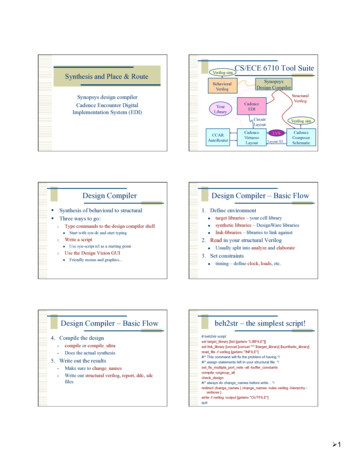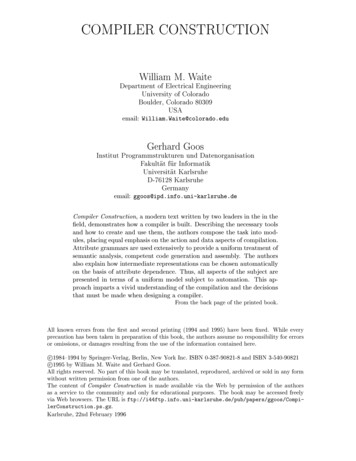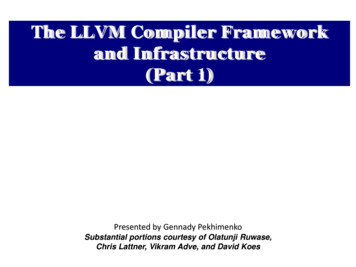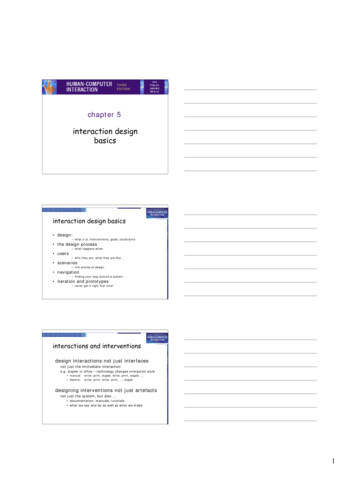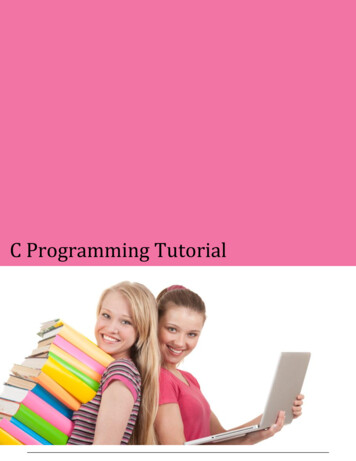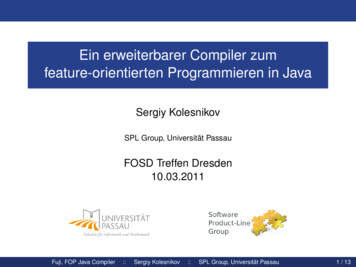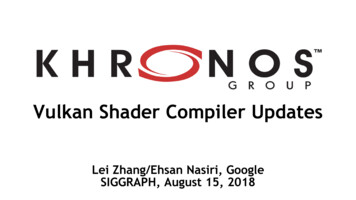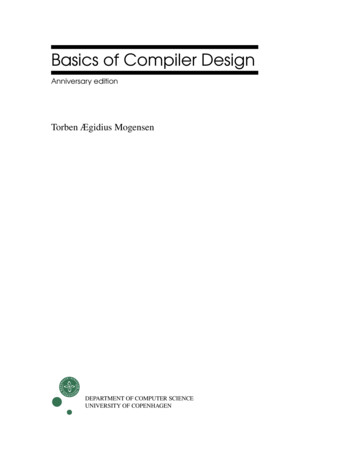
Transcription
Basics of Compiler DesignAnniversary editionTorben Ægidius MogensenDEPARTMENT OF COMPUTER SCIENCEUNIVERSITY OF COPENHAGEN
Published through lulu.com.cTorben Ægidius Mogensen 2000 – 2010torbenm@diku.dkDepartment of Computer ScienceUniversity of CopenhagenUniversitetsparken 1DK-2100 CopenhagenDENMARKBook homepage:http://www.diku.dk/ torbenm/BasicsFirst published 2000This edition: August 20, 2010ISBN 978-87-993154-0-6
Contents12Introduction1.1 What is a compiler? . . . . .1.2 The phases of a compiler . .1.3 Interpreters . . . . . . . . .1.4 Why learn about compilers?1.5 The structure of this book . .1.6 To the lecturer . . . . . . . .1.7 Acknowledgements . . . . .1.8 Permission to use . . . . . .112345677Lexical Analysis2.1 Introduction . . . . . . . . . . . . . . . .2.2 Regular expressions . . . . . . . . . . . .2.2.1 Shorthands . . . . . . . . . . . .2.2.2 Examples . . . . . . . . . . . . .2.3 Nondeterministic finite automata . . . . .2.4 Converting a regular expression to an NFA2.4.1 Optimisations . . . . . . . . . . .2.5 Deterministic finite automata . . . . . . .2.6 Converting an NFA to a DFA . . . . . . .2.6.1 Solving set equations . . . . . . .2.6.2 The subset construction . . . . . .2.7 Size versus speed . . . . . . . . . . . . .2.8 Minimisation of DFAs . . . . . . . . . .2.8.1 Example . . . . . . . . . . . . .2.8.2 Dead states . . . . . . . . . . . .2.9 Lexers and lexer generators . . . . . . . .2.9.1 Lexer generators . . . . . . . . .2.10 Properties of regular languages . . . . . .2.10.1 Relative expressive power . . . .2.10.2 Limits to expressive power . . . .9910131415182022232326293032343541424244.i.
iiCONTENTS2.10.3 Closure properties . . . . . . . . . . . . . . . . . . . . .2.11 Further reading . . . . . . . . . . . . . . . . . . . . . . . . . . .Exercises . . . . . . . . . . . . . . . . . . . . . . . . . . . . . . . . .3Syntax Analysis3.1 Introduction . . . . . . . . . . . . . . . . . . . . .3.2 Context-free grammars . . . . . . . . . . . . . . .3.2.1 How to write context free grammars . . . .3.3 Derivation . . . . . . . . . . . . . . . . . . . . . .3.3.1 Syntax trees and ambiguity . . . . . . . . .3.4 Operator precedence . . . . . . . . . . . . . . . .3.4.1 Rewriting ambiguous expression grammars3.5 Other sources of ambiguity . . . . . . . . . . . . .3.6 Syntax analysis . . . . . . . . . . . . . . . . . . .3.7 Predictive parsing . . . . . . . . . . . . . . . . . .3.8 Nullable and FIRST . . . . . . . . . . . . . . . . .3.9 Predictive parsing revisited . . . . . . . . . . . . .3.10 FOLLOW . . . . . . . . . . . . . . . . . . . . . .3.11 A larger example . . . . . . . . . . . . . . . . . .3.12 LL(1) parsing . . . . . . . . . . . . . . . . . . . .3.12.1 Recursive descent . . . . . . . . . . . . . .3.12.2 Table-driven LL(1) parsing . . . . . . . . .3.12.3 Conflicts . . . . . . . . . . . . . . . . . .3.13 Rewriting a grammar for LL(1) parsing . . . . . .3.13.1 Eliminating left-recursion . . . . . . . . .3.13.2 Left-factorisation . . . . . . . . . . . . . .3.13.3 Construction of LL(1) parsers summarized3.14 SLR parsing . . . . . . . . . . . . . . . . . . . . .3.15 Constructing SLR parse tables . . . . . . . . . . .3.15.1 Conflicts in SLR parse-tables . . . . . . .3.16 Using precedence rules in LR parse tables . . . . .3.17 Using LR-parser generators . . . . . . . . . . . . .3.17.1 Declarations and actions . . . . . . . . . .3.17.2 Abstract syntax . . . . . . . . . . . . . . .3.17.3 Conflict handling in parser generators . . .3.18 Properties of context-free languages . . . . . . . .3.19 Further reading . . . . . . . . . . . . . . . . . . .Exercises . . . . . . . . . . . . . . . . . . . . . . . . 68788909495989999102104105105
CONTENTS4567iiiScopes and Symbol Tables4.1 Introduction . . . . . . . . . . . . . . . .4.2 Symbol tables . . . . . . . . . . . . . . .4.2.1 Implementation of symbol tables .4.2.2 Simple persistent symbol tables .4.2.3 A simple imperative symbol table4.2.4 Efficiency issues . . . . . . . . .4.2.5 Shared or separate name spaces .4.3 Further reading . . . . . . . . . . . . . .Exercises . . . . . . . . . . . . . . . . . . . .113113114115115117117118118118Interpretation5.1 Introduction . . . . . . . . . . . . . . . . . . .5.2 The structure of an interpreter . . . . . . . . .5.3 A small example language . . . . . . . . . . .5.4 An interpreter for the example language . . . .5.4.1 Evaluating expressions . . . . . . . . .5.4.2 Interpreting function calls . . . . . . .5.4.3 Interpreting a program . . . . . . . . .5.5 Advantages and disadvantages of interpretation5.6 Further reading . . . . . . . . . . . . . . . . .Exercises . . . . . . . . . . . . . . . . . . . . . . .121121122122124124126128128130130Type Checking6.1 Introduction . . . . . . . . . . . . . .6.2 The design space of types . . . . . . .6.3 Attributes . . . . . . . . . . . . . . .6.4 Environments for type checking . . .6.5 Type checking expressions . . . . . .6.6 Type checking of function declarations6.7 Type checking a program . . . . . . .6.8 Advanced type checking . . . . . . .6.9 Further reading . . . . . . . . . . . .Exercises . . . . . . . . . . . . . . . . . 152155Intermediate-Code Generation7.1 Introduction . . . . . . . . . . . .7.2 Choosing an intermediate language7.3 The intermediate language . . . .7.4 Syntax-directed translation . . . .7.5 Generating code from expressions7.5.1 Examples of translation . .
ivCONTENTS7.67.7Translating statements . . . . . . . . . . .Logical operators . . . . . . . . . . . . . .7.7.1 Sequential logical operators . . . .7.8 Advanced control statements . . . . . . . .7.9 Translating structured data . . . . . . . . .7.9.1 Floating-point values . . . . . . . .7.9.2 Arrays . . . . . . . . . . . . . . . .7.9.3 Strings . . . . . . . . . . . . . . .7.9.4 Records/structs and unions . . . . .7.10 Translating declarations . . . . . . . . . . .7.10.1 Example: Simple local declarations7.11 Further reading . . . . . . . . . . . . . . .Exercises . . . . . . . . . . . . . . . . . . . . .89Machine-Code Generation8.1 Introduction . . . . . . . . . . .8.2 Conditional jumps . . . . . . . .8.3 Constants . . . . . . . . . . . .8.4 Exploiting complex instructions8.4.1 Two-address instructions8.5 Optimisations . . . . . . . . . .8.6 Further reading . . . . . . . . .Exercises . . . . . . . . . . . . . . 6206Register Allocation9.1 Introduction . . . . . . . . . . . . . . .9.2 Liveness . . . . . . . . . . . . . . . . .9.3 Liveness analysis . . . . . . . . . . . .9.4 Interference . . . . . . . . . . . . . . .9.5 Register allocation by graph colouring .9.6 Spilling . . . . . . . . . . . . . . . . .9.7 Heuristics . . . . . . . . . . . . . . . .9.7.1 Removing redundant moves . .9.7.2 Using explicit register numbers9.8 Further reading . . . . . . . . . . . . .Exercises . . . . . . . . . . . . . . . . . . .10 Function calls10.1 Introduction . . . . . . . . . . . . . . .10.1.1 The call stack . . . . . . . . . .10.2 Activation records . . . . . . . . . . . .10.3 Prologues, epilogues and call-sequences.209. 209. 209. 210. 211
CONTENTSv10.410.510.610.7Caller-saves versus callee-saves . . . . . . . . . . .Using registers to pass parameters . . . . . . . . . .Interaction with the register allocator . . . . . . . . .Accessing non-local variables . . . . . . . . . . . .10.7.1 Global variables . . . . . . . . . . . . . . .10.7.2 Call-by-reference parameters . . . . . . . . .10.7.3 Nested scopes . . . . . . . . . . . . . . . . .10.8 Variants . . . . . . . . . . . . . . . . . . . . . . . .10.8.1 Variable-sized frames . . . . . . . . . . . . .10.8.2 Variable number of parameters . . . . . . . .10.8.3 Direction of stack-growth and position of FP10.8.4 Register stacks . . . . . . . . . . . . . . . .10.8.5 Functions as values . . . . . . . . . . . . . .10.9 Further reading . . . . . . . . . . . . . . . . . . . .Exercises . . . . . . . . . . . . . . . . . . . . . . . . . .21321521922122122222322622622722722822822922911 Analysis and optimisation11.1 Data-flow analysis . . . . . . . . . . . . . . . . . . . . . . . . . .11.2 Common subexpression elimination . . . . . . . . . . . . . . . .11.2.1 Available assignments . . . . . . . . . . . . . . . . . . .11.2.2 Example of available-assignments analysis . . . . . . . .11.2.3 Using available assignment analysis for common subexpression elimination . . . . . . . . . . . . . . . . . . . .11.3 Jump-to-jump elimination . . . . . . . . . . . . . . . . . . . . .11.4 Index-check elimination . . . . . . . . . . . . . . . . . . . . . .11.5 Limitations of data-flow analyses . . . . . . . . . . . . . . . . . .11.6 Loop optimisations . . . . . . . . . . . . . . . . . . . . . . . . .11.6.1 Code hoisting . . . . . . . . . . . . . . . . . . . . . . . .11.6.2 Memory prefetching . . . . . . . . . . . . . . . . . . . .11.7 Optimisations for function calls . . . . . . . . . . . . . . . . . . .11.7.1 Inlining . . . . . . . . . . . . . . . . . . . . . . . . . . .11.7.2 Tail-call optimisation . . . . . . . . . . . . . . . . . . . .11.8 Specialisation . . . . . . . . . . . . . . . . . . . . . . . . . . . .11.9 Further reading . . . . . . . . . . . . . . . . . . . . . . . . . . .Exercises . . . . . . . . . . . . . . . . . . . . . . . . . . . . . . . . .23123223323323612 Memory management12.1 Introduction . . . .12.2 Static allocation . .12.2.1 Limitations12.3 Stack allocation . .237240241244245245246248249250252254254257. 257. 257. 258. 258
viCONTENTS12.4 Heap allocation . . . . . . . . . . . . . . . . . . . . . . .12.5 Manual memory management . . . . . . . . . . . . . . .12.5.1 A simple implementation of malloc() and free()12.5.2 Joining freed blocks . . . . . . . . . . . . . . . .12.5.3 Sorting by block size . . . . . . . . . . . . . . . .12.5.4 Summary of manual memory management . . . .12.6 Automatic memory management . . . . . . . . . . . . . .12.7 Reference counting . . . . . . . . . . . . . . . . . . . . .12.8 Tracing garbage collectors . . . . . . . . . . . . . . . . .12.8.1 Scan-sweep collection . . . . . . . . . . . . . . .12.8.2 Two-space collection . . . . . . . . . . . . . . . .12.8.3 Generational and concurrent collectors . . . . . .12.9 Summary of automatic memory management . . . . . . .12.10Further reading . . . . . . . . . . . . . . . . . . . . . . .Exercises . . . . . . . . . . . . . . . . . . . . . . . . . . . . .13 Bootstrapping a compiler13.1 Introduction . . . . .13.2 Notation . . . . . . .13.3 Compiling compilers13.3.1 Full bootstrap13.4 Further reading . . .Exercises . . . . . . . . .A Set notation and conceptsA.1 Basic concepts and notation . . . .A.1.1 Operations and predicatesA.1.2 Properties of set operationsA.2 Set-builder notation . . . . . . . .A.3 Sets of sets . . . . . . . . . . . .A.4 Set equations . . . . . . . . . . .A.4.1 Monotonic set functions .A.4.2 Distributive functions . . .A.4.3 Simultaneous equations .Exercises . . . . . . . . . . . . . . . 97.
List of 2.14Regular expressions . . . . . . . . . . . . . . . . . . . . . . .Some algebraic properties of regular expressions . . . . . . .Example of an NFA . . . . . . . . . . . . . . . . . . . . . . .Constructing NFA fragments from regular expressions . . . .NFA for the regular expression (a b) ac . . . . . . . . . . . .Optimised NFA construction for regular expression shorthandsOptimised NFA for [0-9] . . . . . . . . . . . . . . . . . . .Example of a DFA . . . . . . . . . . . . . . . . . . . . . . .DFA constructed from the NFA in figure 2.5 . . . . . . . . . .Non-minimal DFA . . . . . . . . . . . . . . . . . . . . . . .Minimal DFA . . . . . . . . . . . . . . . . . . . . . . . . . .Combined NFA for several tokens . . . . . . . . . . . . . . .Combined DFA for several tokens . . . . . . . . . . . . . . .A 4-state NFA that gives 15 DFA states . . . . . . . . . . . 3.83.93.103.113.123.133.143.153.16From regular expressions to context free grammars . . . . . . .Simple expression grammar . . . . . . . . . . . . . . . . . . .Simple statement grammar . . . . . . . . . . . . . . . . . . . .Example grammar . . . . . . . . . . . . . . . . . . . . . . . . .Derivation of the string aabbbcc using grammar 3.4 . . . . . .Leftmost derivation of the string aabbbcc using grammar 3.4 . .Syntax tree for the string aabbbcc using grammar 3.4 . . . . . .Alternative syntax tree for the string aabbbcc using grammar 3.4Unambiguous version of grammar 3.4 . . . . . . . . . . . . . .Preferred syntax tree for 2 3*4 using grammar 3.2 . . . . . . .Unambiguous expression grammar . . . . . . . . . . . . . . . .Syntax tree for 2 3*4 using grammar 3.11 . . . . . . . . . . . .Unambiguous grammar for statements . . . . . . . . . . . . . .Fixed-point iteration for calculation of Nullable . . . . . . . . .Fixed-point iteration for calculation of FIRST . . . . . . . . . .Recursive descent parser for grammar 3.9 . . . . . . . . . . . .56575759595961616263666768717281vii
viiiLIST OF 73.283.293.30LL(1) table for grammar 3.9 . . . . . . . . . . .Program for table-driven LL(1) parsing . . . . .Input and stack during table-driven LL(1) parsingRemoving left-recursion from grammar 3.11 . . .Left-factorised grammar for conditionals . . . . .SLR table for grammar 3.9 . . . . . . . . . . . .Algorithm for SLR parsing . . . . . . . . . . . .Example SLR parsing . . . . . . . . . . . . . . .Example grammar for SLR-table construction . .NFAs for the productions in grammar 3.25 . . . .Epsilon-transitions added to figure 3.26 . . . . .SLR DFA for grammar 3.9 . . . . . . . . . . . .Summary of SLR parse-table construction . . . .Textual representation of NFA states . . . . . . .828383858790919192929394951035.15.25.35.4Example language for interpretationEvaluating expressions . . . . . . .Evaluating a function call . . . . . .Interpreting a program . . . . . . . 123. 125. 127. 1286.16.26.36.4The design space of types . . . . . .Type checking of expressions . . . .Type checking a function declarationType checking a program . . . . . . 134. 137. 139. 1417.17.27.37.47.57.67.77.87.97.107.117.12The intermediate language . . . . . . . .A simple expression language . . . . . .Translating an expression . . . . . . . . .Statement language . . . . . . . . . . . .Translation of statements . . . . . . . . .Translation of simple conditions . . . . .Example language with logical operators .Translation of sequential logical operatorsTranslation for one-dimensional arrays . .A two-dimensional array . . . . . . . . .Translation of multi-dimensional arrays .Translation of simple declarations . . . placement pairs for a subset of the MIPS instruction set .1859.19.2Gen and kill sets . . . . . . . . . . . . . . . . . . . . . . . . . . . 194Example program for liveness analysis and register allocation . . . 195
LIST OF FIGURES9.39.49.59.69.79.89.9succ, gen and kill for the program in figure 9.2 .Fixed-point iteration for liveness analysis . . .Interference graph for the program in figure 9.2Algorithm 9.3 applied to the graph in figure 9.5Program from figure 9.2 after spilling variable aInterference graph for the program in figure 9.7Colouring of the graph in figure 9.8 . . . . . .ix.19619719820220320320410.1 Simple activation record layout . . . . . . . . . . . . . . . . . . . 21110.2 Prologue and epilogue for the frame layout shown in figure 10.1 . 21210.3 Call sequence for x : CALL f (a1 , . . . , an ) using the frame layoutshown in figure 10.1 . . . . . . . . . . . . . . . . . . . . . . . . . 21310.4 Activation record layout for callee-saves . . . . . . . . . . . . . . 21410.5 Prologue and epilogue for callee-saves . . . . . . . . . . . . . . . 21410.6 Call sequence for x : CALL f (a1 , . . . , an ) for callee-saves . . . . . 21510.7 Possible division of registers for 16-register architecture . . . . . . 21610.8 Activation record layout for the register division shown in figure 10.721610.9 Prologue and epilogue for the register division shown in figure 10.7 21710.10Call sequence for x : CALL f (a1 , . . . , an ) for the register divisionshown in figure 10.7 . . . . . . . . . . . . . . . . . . . . . . . . . 21810.11Example of nested scopes in Pascal . . . . . . . . . . . . . . . . . 22310.12Adding an explicit frame-pointer to the program from figure 10.11 22410.13Activation record with static link . . . . . . . . . . . . . . . . . . 22510.14Activation records for f and g from figure 10.11 . . . . . . . . . . 22511.111.211.311.411.511.611.7Gen and kill sets for available assignments . . . . . . . . . . . . . 235Example program for available-assignments analysis . . . . . . . 236pred, gen and kill for the program in figure 11.2 . . . . . . . . . . 237Fixed-point iteration for available-assignment analysis . . . . . . 238The program in figure 11.2 after common subexpression elimination. 239Equations for index-check elimination . . . . . . . . . . . . . . . 242Intermediate code for for-loop with index check . . . . . . . . . . 24412.1 Operations on a free list . . . . . . . . . . . . . . . . . . . . . . .261
xLIST OF FIGURES
Chapter 1Introduction1.1What is a compiler?In order to reduce the complexity of designing and building computers, nearly allof these are made to execute relatively simple commands (but do so very quickly).A program for a computer must be built by combining these very simple commandsinto a program in what is called machine language. Since this is a tedious and errorprone process most programming is, instead, done using a high-level programminglanguage. This language can be very different from the machine language that thecomputer can execute, so some means of bridging the gap is required. This is wherethe compiler comes in.A compiler translates (or compiles) a program written in a high-level programming language that is suitable for human programmers into the low-level machinelanguage that is required by computers. During this process, the compiler will alsoattempt to spot and report obvious programmer mistakes.Using a high-level language for programming has a large impact on how fastprograms can be developed. The main reasons for this are: Compared to machine language, the notation used by programming languages is closer to the way humans think about problems. The compiler can spot some obvious programming mistakes. Programs written in a high-level language tend to be shorter than equivalentprograms written in machine language.Another advantage of using a high-level level language is that the same programcan be compiled to many different machine languages and, hence, be brought torun on many different machines.1
2CHAPTER 1. INTRODUCTIONOn the other hand, programs that are written in a high-level language and automatically translated to machine language may run somewhat slower than programsthat are hand-coded in machine language. Hence, some time-critical programs arestill written partly in machine language. A good compiler will, however, be ableto get very close to the speed of hand-written machine code when translating wellstructured programs.1.2The phases of a compilerSince writing a compiler is a nontrivial task, it is a good idea to structure the work.A typical way of doing this is to split the compilation into several phases withwell-defined interfaces. Conceptually, these phases operate in sequence (though inpractice, they are often interleaved), each phase (except the first) taking the outputfrom the previous phase as its input. It is common to let each phase be handled by aseparate module. Some of these modules are written by hand, while others may begenerated from specifications. Often, some of the modules can be shared betweenseveral compilers.A common division into phases is described below. In some compilers, theordering of phases may differ slightly, some phases may be combined or split intoseveral phases or some extra phases may be inserted between those mentioned below.Lexical analysis This is the initial part of reading and analysing the program text:The text is read and divided into tokens, each of which corresponds to a symbol in the programming language, e.g., a variable name, keyword or number.Syntax analysis This phase takes the list of tokens produced by the lexical analysisand arranges these in a tree-structure (called the syntax tree) that reflects thestructure of the program. This phase is often called parsing.Type checking This phase analyses the syntax tree to determine if the programviolates certain consistency requirements, e.g., if a variable is used but notdeclared or if it is used in a context that does not make sense given the typeof the variable, such as trying to use a boolean value as a function pointer.Intermediate code generation The program is translated to a simple machineindependent intermediate language.Register allocation The symbolic variable names used in the intermediate codeare translated to numbers, each of which corresponds to a register in thetarget machine code.
1.3. INTERPRETERS3Machine code generation The intermediate language is translated to assemblylanguage (a textual representation of machine code) for a specific machinearchitecture.Assembly and linking The assembly-language code is translated into binary representation and addresses of variables, functions, etc., are determined.The first three phases are collectively called the frontend of the compiler and the lastthree phases are collectively called the backend. The middle part of the compiler isin this context only the intermediate code generation, but this often includes variousoptimisations and transformations on the intermediate code.Each phase, through checking and transformation, establishes stronger invariants on the things it passes on to the next, so that writing each subsequent phaseis easier than if these have to take all the preceding into account. For example,the type checker can assume absence of syntax errors and the code generation canassume absence of type errors.Assembly and linking are typically done by programs supplied by the machineor operating system vendor, and are hence not part of the compiler itself, so we willnot further discuss these phases in this book.1.3InterpretersAn interpreter is another way of implementing a programming language. Interpretation shares many aspects with compiling. Lexing, parsing and type-checking arein an interpreter done just as in a compiler. But instead of generating code fromthe syntax tree, the syntax tree is processed directly to evaluate expressions andexecute statements, and so on. An interpreter may need to process the same pieceof the syntax tree (for example, the body of a loop) many times and, hence, interpretation is typically slower than executing a compiled program. But writing aninterpreter is often simpler than writing a compiler and the interpreter is easier tomove to a different machine (see chapter 13), so for applications where speed is notof essence, interpreters are often used.Compilation and interpretation may be combined to implement a programminglanguage: The compiler may produce intermediate-level code which is then interpreted rather than compiled to machine code. In some systems, there may even beparts of a program that are compiled to machine code, some parts that are compiledto intermediate code, which is interpreted at runtime while other parts may be keptas a syntax tree and interpreted directly. Each choice is a compromise betweenspeed and space: Compiled code tends to be bigger than intermediate code, whichtend to be bigger than syntax, but each step of translation improves running speed.Using an interpreter is also useful during program development, where it ismore important to be able to test a program modification quickly rather than run
4CHAPTER 1. INTRODUCTIONthe program efficiently. And since interpreters do less work on the program beforeexecution starts, they are able to start running the program more quickly. Furthermore, since an interpreter works on a representation that is closer to the source codethan is compiled code, error messages can be more precise and informative.We will discuss interpreters briefly in chapters 5 and 13, but they are not themain focus of this book.1.4Why learn about compilers?Few people will ever be required to write a compiler for a general-purpose languagelike C, Pascal or SML. So why do most computer science institutions offer compilercourses and often make these mandatory?Some typical reasons are:a) It is considered a topic that you should know in order to be “well-cultured”in computer science.b) A good craftsman should know his tools, and compilers are important toolsfor programmers and computer scientists.c) The techniques used for constructing a compiler are useful for other purposesas well.d) There is a good chance that a programmer or computer scientist will need towrite a compiler or interpreter for a domain-specific language.The first of these reasons is somewhat dubious, though something can be said for“knowing your roots”, even in such a hastily changing field as computer science.Reason “b” is more convincing: Understanding how a compiler is built will allow programmers to get an intuition about what their high-level programs will looklike when compiled and use this intuition to tune programs for better efficiency.Furthermore, the error reports that compilers provide are often easier to understandwhen one knows about and understands the different phases of compilation, suchas knowing the difference between lexical errors, syntax errors, type errors and soon.The third reason is also quite valid. In particular, the techniques used for reading (lexing and parsing) the text of a program and converting this into a form (abstract syntax) that is easily manipulated by a computer, can be used to read andmanipulate any kind of structured text such as XML documents, address lists, etc.Reason “d” is becoming more and more important as domain specific languages(DSLs) are gaining in popularity. A DSL is a (typically small) language designedfor a narrow class of problems. Examples are data-base query languages, textformatting languages, scene description languages for ray-tracers and languages
1.5. THE STRUCTURE OF THIS BOOK5for setting up economic simulations. The target language for a compiler for a DSLmay be traditional machine code, but it can also be another high-level languagefor which compilers already exist, a sequence of control signals for a machine,or formatted text and graphics in some printer-control language (e.g. PostScript).Even so, all DSL compilers will share similar front-ends for reading and analysingthe program text.Hence, the methods needed to make a compiler front-end are more widely applicable than the methods needed to make a compiler back-end, but the latter ismore important for u
Contents 1 Introduction 1 1.1 What is a compiler? . . . . . . . . . . . . . . . . . . . . . . . . . 1 1.2 The phases of a compiler .
